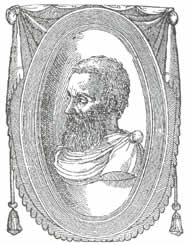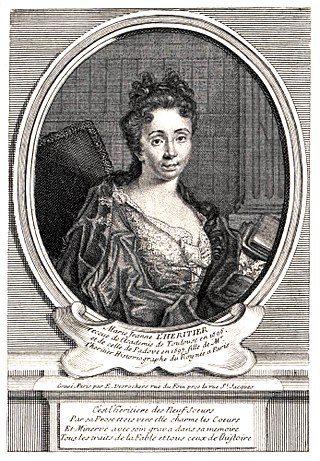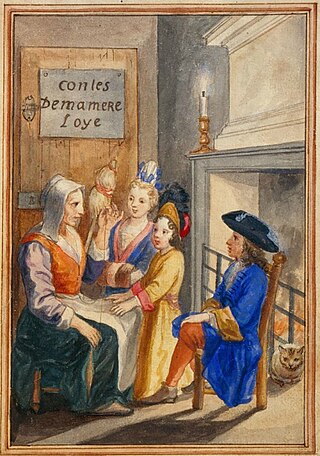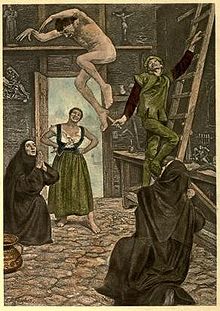
A fairy tale is a short story that belongs to the folklore genre. Such stories typically feature magic, enchantments, and mythical or fanciful beings. In most cultures, there is no clear line separating myth from folk or fairy tale; all these together form the literature of preliterate societies. Fairy tales may be distinguished from other folk narratives such as legends and explicit moral tales, including beast fables. Prevalent elements include dwarfs, dragons, elves, fairies, giants, gnomes, goblins, griffins, mermaids, talking animals, trolls, unicorns, monsters, witches, wizards, and magic and enchantments.

Sleeping Beauty, also titled in English as The Sleeping Beauty in the Woods, is a fairy tale about a princess cursed by an evil fairy to sleep for a hundred years before being awakened by a handsome prince. A good fairy, knowing the princess would be frightened if alone when she wakes, uses her wand to put every living person and animal in the palace and forest asleep, to waken when the princess does.

Giambattista Basile was an Italian poet, courtier, and fairy tale collector. His collections include the oldest recorded forms of many well-known European fairy tales. He is chiefly remembered for writing the collection of Neapolitan fairy tales known as Il Pentamerone.

Giovanni Francesco "Gianfrancesco" Straparola, also known as Zoan or Zuan Francesco Straparola da Caravaggio, was an Italian writer of poetry, and collector and writer of short stories. Some time during his life, he migrated from Caravaggio to Venice where he published a collection of stories in two volumes called The Facetious Nights or The Pleasant Nights. This collection includes some of the first known printed versions of fairy tales in Europe, as they are known today.

The Pentamerone, subtitled Lo cunto de li cunti, is a seventeenth-century Neapolitan fairy tale collection by Italian poet and courtier Giambattista Basile.

"The Three Little Men in the Wood" or "The Three Little Gnomes in the Forest" is a German fairy tale collected in 1812 by the Brothers Grimm in Grimm's Fairy Tales. Andrew Lang included it in The Red Fairy Book (1890) as "The Three Dwarfs," and a version of the tale appears in A Book of Dwarfs (1964) by Ruth Manning-Sanders.
The Grateful Beasts is a Hungarian fairy tale collected by Georg von Gaal in Mährchen der Magyaren (1822). The tale was also published by Hermann Kletke in Märchensaal, Vol II (1845).
"The Pig King" or "King Pig" is an Italian literary fairy tale written by Giovanni Francesco Straparola in his The Facetious Nights of Straparola. Madame d'Aulnoy wrote a French, also literary, variant, titled Prince Marcassin.
"The Four Skillful Brothers" is a German fairy tale collected by the Brothers Grimm. It is Aarne-Thompson type 653.
Biancabella and the Snake is an Italian literary fairy tale written by Giovanni Francesco Straparola in The Facetious Nights of Straparola.
Maestro Lattantio and His Apprentice Dionigi is an Italian literary fairy tale written by Giovanni Francesco Straparola in The Facetious Nights of Straparola.

Marie-Jeanne L'Héritier de Villandon was an aristocratic French writer and salonnière of the late 17th century, and a niece of Charles Perrault.
Costanza / Costanzo is an Italian literary fairy tale written by Giovanni Francesco Straparola in The Facetious Nights of Straparola.

Grateful dead is both a motif and a group of related folktales present in many cultures throughout the world.

"Puss in Boots" is a European fairy tale about an anthropomorphic cat who uses trickery and deceit to gain power, wealth, and the hand in marriage of a princess for his penniless and low-born master.

Histoires ou contes du temps passé, avec des moralités or Contes de ma mère l'Oye is a collection of literary fairy tales written by Charles Perrault, published in Paris in 1697. The work became popular because it was written at a time when fairy tales were fashionable amongst aristocrats in Parisian literary salons. Perrault wrote the work when he retired from court as secretary to Jean-Baptiste Colbert, minister to Louis XIV of France. Colbert's death may have forced Perrault's retirement, at which point he turned to writing. Scholars have debated as to the origin of his tales and whether they are original literary fairy tales modified from commonly known stories, or based on stories written by earlier medieval writers such as Boccaccio.
Ruth B. Bottigheimer is a literary scholar, folklorist, and author. She is currently Research Professor in the department of English at Stony Brook University, State University of New York where she specializes in European fairy tales and British children’s literature. She is also interested in the history of illustration and the religious socialization of children through edited Bible narratives. She “has been hailed as one of America’s foremost Grimm scholars”.

Giovanni Sercambi (1348–1424) was an Italian author from Lucca who wrote a history of his city, Le croniche di Luccha, as well as Il novelliere, a collection of 155 tales.
Fairer-than-a-Fairy or More Beautiful Than Fairy is a literary fairy tale by Charlotte-Rose de Caumont de La Force in 1698.
In folkloristics, "The Animal as Bridegroom" refers to a group of folk and fairy tales about a human woman marrying or being betrothed to an animal. The animal is revealed to be a human prince in disguise or under a curse. Most of these tales are grouped in the international system of Aarne-Thompson-Uther Index under type ATU 425, "The Search for the Lost Husband". Some subtypes exist in the international classification as independent stories, but they sometimes don't adhere to a fixed typing.











